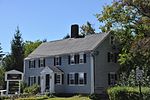Newburyport station
1840 establishments in MassachusettsBuildings and structures in Newburyport, MassachusettsFormer Boston and Maine Railroad stationsMBTA Commuter Rail stations in Essex County, MassachusettsRailway stations closed in 1976 ... and 1 more
Railway stations in the United States opened in 1840

Newburyport station is an MBTA Commuter Rail station in Newburyport, Massachusetts. It is located between Parker Street and U.S. Route 1 south of downtown Newburyport, and serves the Newburyport/Rockport Line. The station is the terminus of the Newburyport Branch of the line, with three parking lots totalling over 800 spaces. The Clipper City Rail Trail, running along the former right-of-way, connects the station to the town center. Newburyport station is fully accessible.
Excerpt from the Wikipedia article Newburyport station (License: CC BY-SA 3.0, Authors, Images).Newburyport station
Boston Way, Newburyport Lord Timothy Dexter Industrial Green
Geographical coordinates (GPS) Address Website Nearby Places Show on map
Geographical coordinates (GPS)
| Latitude | Longitude |
|---|---|
| N 42.79815 ° | E -70.87815 ° |
Address
Metzy's Cantina
Boston Way 25
01922 Newburyport, Lord Timothy Dexter Industrial Green
Massachusetts, United States
Open on Google Maps










